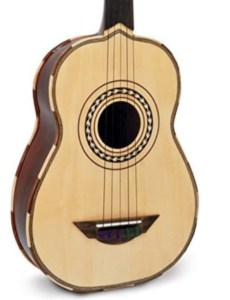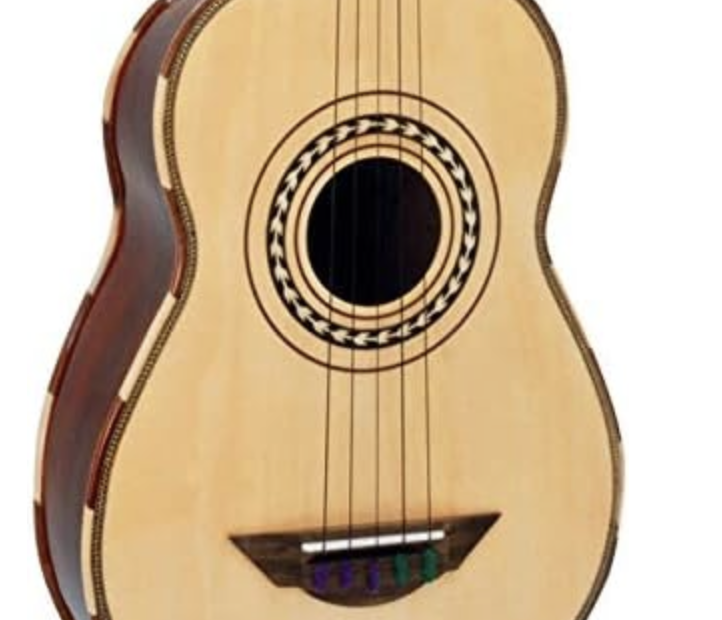The Mexican guitar, a soulful and evocative instrument, holds a special place in the heart of Mexican culture. Reverberating with rich history, it is a symbol of the nation’s musical heritage and a reflection of the diverse and vibrant Mexican traditions.
This article embarks on a melodious journey, exploring the various types of Mexican guitars, their unique characteristics, and their significant contributions to the tapestry of Mexican music.
 The Mariachi Guitar
The Mariachi Guitar
One of the most iconic and celebrated Mexican guitars is the Mariachi guitar. Central to the Mariachi ensemble, this instrument resonates with the joy, passion, and camaraderie of Mexican life. The Mariachi guitar boasts a bright and lively tone, allowing it to weave intricate melodies and powerful harmonies alongside the trumpets, violins, and other instruments that comprise the Mariachi band. With its distinctive design and intricate detailing, the Mariachi guitar is an emblematic sight at fiestas, weddings, and traditional gatherings throughout Mexico.
The Vihuela
The Vihuela is another enchanting member of the Mexican guitar family. This small, five-stringed instrument is characterized by its rounded back, giving it a unique shape that complements its delightful sound. The Vihuela plays an integral role in Mariachi music, often working in tandem with the Mariachi guitar to create a well-rounded and melodious ensemble. Its rhythmic strumming and lively chords add a buoyant quality to the music, making it irresistible for both musicians and listeners alike.
The Jarana
Originating from the state of Veracruz, the Jarana is a lively and spirited guitar-like instrument commonly used in the traditional Son Jarocho music of the region. With its small body and ten strings arranged in five courses, the Jarana packs a powerful sound that reverberates with the vitality of Veracruz. Often played in communal gatherings, known as “Fandangos,” the Jarana is a testament to the warmth and unity of Mexican music and culture.
Also Read:
Who Invented the Guitar (Guitar Inventor)
The 8-String Guitar: Expanding Your Possibilities
Classical Guitar vs Acoustic: Understanding the Differences
Guitar Anatomy: Understanding Guitar Components
The 10 Best Washburn Acoustic Guitar Models
Guitar Wireless System: Unleashing Freedom
The Huapanguera
Native to the Huasteca region, the Huapanguera is a large, deep-bodied guitar with a profoundly resonant sound. Traditionally played in the Son Huasteco genre, this instrument accompanies the soul-stirring falsetto vocals that evoke the emotions of love, loss, and life in rural Mexico. The Huapanguera’s captivating melodies paint a vivid picture of the Huasteca landscape, carrying its listeners on a heartfelt musical journey.
 Features of the Mexican Guitar
Features of the Mexican Guitar
The Guitarrón is a large, traditional Mexican folk instrument that belongs to the guitar family. It is a significant component of Mexican mariachi ensembles, adding a distinctive and powerful bass sound to the group. The name “guitarrón” translates to “big guitar” in Spanish, and its appearance is similar to that of an oversized guitar or a large acoustic bass.
Here are some key features and characteristics of the Guitarrón:
- Size and Shape: The Guitarrón is notably larger than a standard guitar, measuring around 2 meters (approximately 6.5 feet) in length. It has a deep, wide body and a round back, creating a resonant chamber that produces a rich and booming sound.
- Strings: Traditionally, the Guitarrón has six strings, with the tuning and string gauges varying depending on the region and individual preferences. However, it is common to see modern variations with up to ten strings.
- Tuning: The Guitarrón is often tuned in an open tuning, meaning the strings are tuned to specific pitches that complement the style of playing. Popular tunings include ADGC or GCEA.
- Materials: The top of the Guitarrón is typically made from cedar or spruce, while the sides and back are made of a hardwood such as mahogany or rosewood. The fretboard is typically made of a dark wood, such as rosewood, and it may have inlays for fret markers.
- Playing Style: The Guitarrón is played using a combination of plucking and strumming techniques. The player uses their fingers to create rhythmic patterns and basslines, adding a melodic and percussive element to the mariachi ensemble.
- Mariachi Music: The Guitarrón is an integral part of traditional Mexican mariachi music. Mariachi bands typically consist of several violins, trumpets, a vihuela (a small five-string guitar-like instrument), and a Guitarrón. The Guitarrón provides the essential bass foundation, helping to drive the rhythm and harmonize with the other instruments.
- Folklore and Cultural Significance: The Guitarrón has deep cultural roots in Mexican folklore and music. Its distinctive sound is associated with celebrations, festivals, and traditional events, making it a symbol of Mexican identity and pride.
The Guitarrón is a remarkable instrument that plays a vital role in Mexican culture and music. Its deep, resonant tones add warmth and power to the traditional mariachi ensemble.
Related Instruments
Mexican music is characterized by a rich variety of traditional instruments that complement the enchanting sound of the Mexican guitar. Some related instruments that play a significant role in various Mexican music genres include:
- Trumpet: The trumpet is a brass instrument commonly used in Mariachi music. Its bright and powerful sound adds a majestic touch to the ensemble, elevating the festive spirit of celebrations and festivals.
- Violin: The violin is a versatile and emotive instrument that plays a central role in Mariachi and Son Jarocho music. Its expressive melodies beautifully harmonize with the guitars, creating a captivating musical experience.
- Guitarrón: The Guitarrón is a large, deep-bodied bass guitar used in Mariachi music. It provides the foundational low-end notes that enhance the rhythmic drive and resonance of the Mariachi ensemble.
- Requinto Jarocho: This small, four-stringed guitar is a vital part of Son Jarocho music. Its bright and high-pitched sound complements the Vihuela, providing additional harmonies and intricate melodic patterns.
- Harp: The traditional Mexican harp is a majestic instrument that adds an ethereal quality to certain music styles like the Son Jarocho. With its graceful plucking of strings, it imparts an enchanting and romantic atmosphere.
- Jarana Jarocha: Similar in appearance to the Jarana, this instrument is used in the traditional Son Jarocho music of Veracruz. It has a distinct sound that enriches the lively and dynamic melodies of the genre.
- Arpa Grande: Also known as the “grand harp,” the Arpa Grande is a large, elaborate harp used in the music of the Huasteca region. Its deep, resonant tones form an essential component of Son Huasteco ensembles.
- Violoncello: In some classical Mexican music arrangements, the cello provides a rich and velvety bass foundation, adding depth and complexity to the ensemble.
- Marimba: The marimba is a percussion instrument that finds its place in Mexican folk music, especially in the southern regions. Its vibrant and melodic tones contribute to the festive ambiance of local celebrations.
- Accordion: The accordion, an instrument of European origin, has integrated itself into various Mexican music styles, particularly Norteño and Conjunto music. Its distinct sound adds an element of nostalgia and romance to the melodies.
Conclusion
The Mexican guitar family encompasses a wide array of enchanting instruments, each contributing to the diverse tapestry of Mexican music.
From the lively strumming of the Mariachi guitar to the heartfelt melodies of the Huapanguera, each instrument tells a unique story of Mexican culture, history, and identity.
These guitars form the backbone of traditional music, adding soulful melodies, rhythmic chords, and heartfelt expressions to the rich musical heritage of Mexico.
As they continue to grace celebrations, ceremonies, and gatherings across the nation, the Mexican guitars’ timeless allure remains a cherished and vital aspect of Mexico’s cultural identity.
